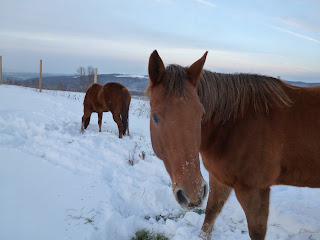- The weight of the horse: the heavier the horse, the less likely it is that their hooves are contracted. Drafts can have sorry, sad feet and still have very little contraction, small ponies and minis are the opposite.
- Movement: Allison had it quite right in her comment on my last post, movement is essential. Without movement and heel first landings the hooves will contract. Standing = stagnation.
- The hardness/softness of the surface they live on: hard surfaces offer more resistance to the hoof causing it to expand wider, soft surfaces are the opposite. Mud or soft sand can contribute to contraction.
- The moisture content of said surface: here's a bit of a contradiction to the last point, drier environments leave hooves more contracted than wet ones. This is because tissues tend to shrink when water isn't abundant. A healthy hoof in a desert environment will probably look more contracted than a healthy hoof in a more humid environment.
- Injury/disease: if one hoof is contracted, I would suspect an injury in the leg or disease in the hoof. Anything that makes it uncomfortable for the horse to land on that hoof correctly.
- Shoes: when the horse weights the hoof it expands, when they lift the hoof it contracts. In order to nail a shoe onto a hoof it has to be lifted- so the hoof is already at it's smallest when the shoe is nailed on. The nails will then interfere with the normal flexing of the hoof once the horse starts moving again, and if the nails are placed too far back they will interfere with the expansion of the heels. Shoes lock the hoof into its smallest (contracted) size which can get worse over time. I've heard there are farriers out there who can avoid this, but they are very, very few and far between.
Okay, onto the pictures.
Personally I think those hooves were contracted due to the pain from the bars (cue the broken record...). The bars are meant to give structure to the back of the hoof and to keep it from expanding too far upon impact with the ground. If the bars are left to grow unchecked, they can grow so long that, not only do they cause pain, they actually stop the back of the hoof from expanding. When the hoof can't expand all it can do is contract.
Lets look at some of those pictures a little closer, shall we?
The red lines outline the bars, the blue lines are there to show how deep they've grown into the hoof. Keep in mind that you can't see all of the bar, there's probably quite a bit that has been pushed up inside the hoof too. The accordion folds are a tell-tale of too long bars. Those are compression folds that are created when the too long bars get squeezed between the inside of the hoof and the ground.
I know there are some out there that still don't think bars need to be trimmed, all I can say is that every time I've trimmed off overgrown bars one of two things happen: they either start licking and chewing (a sign that a stressor was removed) or they pick up a hoof I haven't gotten to yet and ask me to do that one too. I imagine the horses in the photos would react the same way.
I know there are some out there that still don't think bars need to be trimmed, all I can say is that every time I've trimmed off overgrown bars one of two things happen: they either start licking and chewing (a sign that a stressor was removed) or they pick up a hoof I haven't gotten to yet and ask me to do that one too. I imagine the horses in the photos would react the same way.



















































